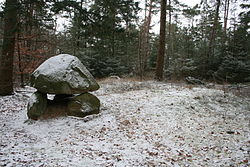Henkenstein stone grave
| Henkenstein stone grave | ||
|---|---|---|
|
Henkenstein stone grave |
||
|
|
||
| Coordinates | 53 ° 44 '35 " N , 8 ° 40' 2.8" E | |
| place | Wanhöden , Lower Saxony , Germany | |
| Emergence | 3500 to 2800 BC Chr. | |
| Sprockhoff no. | 606 | |
The large stone grave Henkenstein (also known as the large stone grave Midlum 1 ) near Wanhöden in the state of Wursten in Lower Saxony with the Sprockhoff no. 606 was created between 3500 and 2800 BC. BC as a megalithic system of the funnel beaker culture (TBK).
The remaining part is the west end of a larger chamber. A large capstone and 3 bearing stones have been preserved in situ and look like the remains of a simple dolmen , which they are not. Remains of the grave hill preserved and by E. Sprockhoff the grave had originally m, a length of 6 to 8, which corresponds to a region typical passage grave would correspond.
According to the literature of the 19th century, the population regarded this type of structure as a pre-Christian altar.
See also
literature
- Ernst Sprockhoff : Atlas of the megalithic tombs Germany. Part 3: Lower Saxony - Westphalia. Rudolf Habelt Verlag, Bonn 1975, ISBN 3-7749-1326-9
- Jürgen E. Walkowitz: The megalithic syndrome. European cult sites of the Stone Age (= contributions to the prehistory and early history of Central Europe. Vol. 36). Beier & Beran, Langenweißbach 2003, ISBN 3-930036-70-3 .

